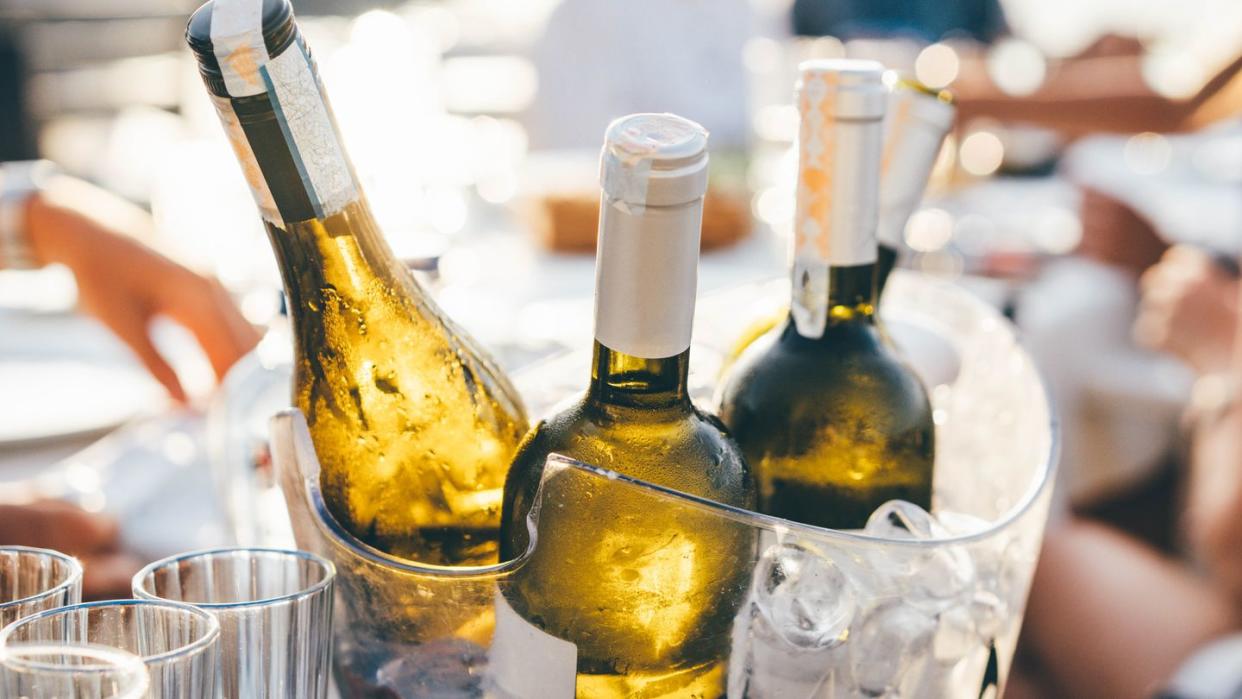4 White Wines Sommeliers Say You Should Always Have on Hand

"Hearst Magazines and Yahoo may earn commission or revenue on some items through these links."
It’s common to enjoy a glass of vino without understanding a single thing about its history, production methods, and tasting notes. Winemaking can be quite complicated—especially for a typical imbiber who simply wants a delicious glass of wine without the long-winded explanation about where it comes from and how it interacts with the palate.
But with a seemingly never-ending list of options—from mainstream blends found in grocery stores to special varietals found in wine shops—it’s sometimes important to leave your happy hour decisions to the experts. We interviewed six sommeliers from around the country to get a sense of the bottles of white wine they always have on hand at a moment’s notice.
Why white wine? Rachel Thralls, certified sommelier and wine education consultant says, "White wine is always good to have on hand since it's extremely versatile, is fresh, crisp and refreshing while pairing well with a variety of foods."
Plus, these white wines not only taste delicious, but can also complement (and even enhance!) most meals with their texture, tannin levels, and flavor nuances derived from the grape, terroir, climate, and aging process.
Check out their picks below, as well as more mainstream options that are easily accessible through online delivery services.
Grüner Veltliner
Warm weather demands a libation that’s light, juicy, and sippable in any al fresco dining situation. And while it may be anyone’s instinct to grab the first cold bottle of pinot grigio or sauvignon blanc they can find at the liquor store, a grüner veltliner can elevate any sipping experience with its unique flavor complexity.
“When it comes to wine, there are few varietals as intriguing and versatile as grüner veltliner,” explains Thralls. “This white wine from Austria is known for its vibrant acidity, refreshing citrus and green apple notes, and subtle hints of white pepper and spice.”
“Grüner Veltliner is a zippy alternative to Sauvignon Blanc,” adds Pamela Vachon, New York-based food and travel writer and certified sommelier. “It [also] happens to be a great pairing for veggies, which often don't get spoken of when we talk about how to pair food and wine.”
Hiedler Loss is an “easy-to-find, accessible option” that will “make your wallet and your palate happy,” she recommends, while Thralls touts a Nigl Freiheit to complement seafood, Asian cuisine, or “just a big salad.” She adds, “It’s the one bottle I always have on hand.”
Chardonnay
Chardonnay’s signature oakiness complements dishes like briny shellfish, baked chicken, and ultra-creamy cheeses.
“I always have chardonnay from France in my fridge,” says Liz Martinez, general manager and sommelier of Detroit’s The Apparatus Room. “With its ability to pair with just about everything, a wine that is kissed by oak and still showcases the purity of fruit is what I seek when selecting a ‘house wine.’”
While Martinez suggests a Marcel Couturier Les Longues Terres from France, this Brocard Chablis Vaulorent Premier Cru is typically more readily available for U.S. consumers.
Bubbles
“Once you pop, the fun don’t stop,” may have been Pringles’ catchphrase in the late '90s, but it applies to sparkling wines, as well.
Of course, Champagne is probably the first bottle that comes to mind for anyone hoping to celebrate at a moment’s notice.
“I am always stocked with Champagne,” reveals Henna Bakshi, Atlanta-based food and wine writer and WSET level two-certified sommelier. “Philippe Gonet Grand Cru Blanc de Blanc is one of my favorites.” She adds, “It drinks beautifully now, but will cellar for years to come.” (Champagne Michel Gonet Zero Dosage Blanc de Blancs Grand Cru is a similar and more widely available alternative.)
Bakshi is also quick to divulge a few Champagne pro tips so that anyone can maximize their happy hour, dinner party, or outdoor soiree.
“Boot the flute,” she advises. “Pour sparkling wine in a regular white wine glass to get more aromas and flavors. A flute does not allow you to swirl the wine (yes, you can and should swirl bubbles) and the narrow glass does not offer any space for aromas to collect.”
“Treat good quality bubbles with the same respect as any other good quality wine,” she adds.
Riesling
“Anyone who comes to my home will always be treated to Alsatian riesling,” says Ian Lokey, beverage director for for Sushi Note Restaurants in Sherman Oaks, California.
The dry, mineral-forward wine accompanies practically everything except heavy red meat dishes, making it one of the most versatile on the market.
“It’s also an added surprise for people unfamiliar with the concept that dry riesling not only exists but is very common,” he adds, recommending a bottle of Domaine Weinbach due to its range of accessible price points.
Paula de Pano, owner of Rocks and Acid Wine Shop in Chapel Hill, North Carolina, echoes these sentiments with a love for the German varietal.
“Living in the south always means that there has to be a bottle of wine that has pronounced acidity in my fridge. The last thing I would want on a 90-degree day is a wine that has lots of alcohol and a hefty texture. That's like putting on a wool coat while baking under the Carolina sun!,” she jokes.
But de Pano does welcome a touch of sweetness with her top off-dry pick from Seehof Elektrisch, which she describes as a lip-smacking “lemon-apple candy juice.”
Still struggling to find the perfect vino? Don’t hesitate to ask a store manager or owner of your favorite liquor or wine shop by giving them a set of guidelines like price, type, and potential pairings. More times than not, they’ll be eager to share their knowledge and help you identify what could be your new favorite bottle.
You Might Also Like






